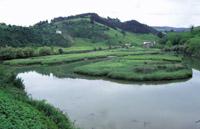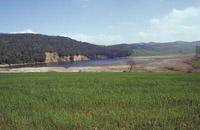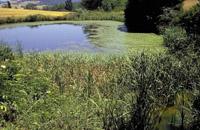Wetlands of the Basque Country (III): human beings and wetlands
2000/05/01 Estonba Mintxero, Mikel Iturria: Elhuyar aldizkaria
The relationship between humans and wetlands has always been very close, since the abundance of resources offered by these rich ecosystems make environments very attractive to humans. However, the relationship between humans and wetlands has been evolving throughout history, and although it was initially based on a rational exploitation of resources, in recent years it has been characterized by the destruction of wetlands.
We consider it essential to understand the current situation of wetlands and to define the measures to be taken in the future, to review the historical evolution of the relationship between human beings and wetlands, to take a look at the past, which can be of great help when deciding on the management and protection of them.
At first, the inadequate conditions of wetlands for human settlement limited the relationship between man and wetlands to the exploitation of the trophic resources of these ecosystems. The hunting that was practiced in wetlands, fishing, seafood (in the case of coastal wetlands) was an important trophic complement for the human groups that lived in their vicinity, so these settlements experienced a remarkable growth with respect to others, constituting on many occasions at the starting point of sedentary human communities.
In the second stage that extends in the Basque Country from the Roman era to approximately the last century, as a result of some wetland resources beginning to see exploitation for productive purposes, man began to transform wetlands. It should be mentioned, however, that these first transformations were carried out in order to promote one or more specific aspects of the functioning of wetlands, but in no case did they entail a substantial modification of the process or physiognomy thereof. This, although affecting wetlands in some way, showed a balanced interaction between nature and exemplary human activity within the framework of current sustainable development. More significant examples of this type of relationship would be the salt flats built in wetlands and saline rivers, rice fields, soda (sodium carbonate) used to make glass and soap and vitreous herbs (Salsola sp.) to obtain potash (potassium carbonate). The exploitation, the use as fodder for the livestock, the collection of pantanous plants for cestería or construction, the extraction of mud for the manufacture of pecios and bricks, the health baths...
Although in some places it began earlier, in the third stage that extends from the last century to the present day, the relationship between man and wetlands has been characterized by man's attitude towards the destruction of wetlands. In this period, the sustainable exploitation of wetland resources has been replaced by drains, drying and filling that have simplified wetlands. In this period, the human being has preferred to use in agriculture the lands that occupy wetlands instead of exploiting their natural production.
This last trend has had a great level in the twentieth century. In the nineteenth century, and, above all, from the 1950s onwards, the use of agricultural machinery and the emergence of powerful technical means have led to the drying up of large, well preserved wet areas. In most cases, in addition, they have been initiatives promoted or subsidized by the administration itself, since until recently the endemic malaria related to wetlands provoked an authentic war against wetlands. As an example we can cite the Cambó Law, passed in Spain in 1919 and in force until 1985. Through this law, public administrations granted subsidies and incentives for drying lagoons, ponds and wetlands in general. Similar measures were promoted by the Grand Irrigation Law of 1939 or by the Agrarian Reform and Development Act of 1973.
Unfortunately, the consequences of the technological development of recent decades have not been limited to turning wetlands into farmland. In some cases, the transformations carried out in wetlands have been much more serious. This phenomenon has been more pronounced in coastal wetlands. In many of them, the soil needs derived from the industrialization and demographic growth have been met by the drainage and drought of the flat and extensive areas of the marshes. In this sense, it is worth mentioning the influence of the growth of tourism in our coast during the last years in these ecosystems, since the urbanizations and infrastructures (parking, camping, sports docks, etc.) Carried out until the end, in addition to destroying most of the dunes of our beaches, they have caused the drying of several small and medium marshes, which until recently had been maintained.
All this, in addition, has led to the proliferation of discharges of all kinds, with which the water of many wetlands has been contaminated. Despite the fact that pollution in the agrarian districts has been caused by the pesticides and fertilizers used in the irrigation areas, industrial and urban spills are the main cause of contamination in peripheral wetlands.
In this stage of relationship between the human being and the wetlands there have been other remarkable aggressions: the intensification of the irrigation areas by the exhaustion of several aquifers or the decrease of the water surface; the negative impact of the introduction of various animal and vegetable species coming from abroad in the native fauna and flora; the infrastructures built on the wetlands (roads, railroads, electric networks, etc. ); overexploitation of natural resources, the use of landfills and irrigation water.
However, in recent years, something seems to be changing in this devastating dynamic. Research that has highlighted the high natural and ecological value of wetlands has made the conservation of wetlands a priority target for ecological and naturalistic groups. The informative work carried out by these groups in order to make known the value of wetlands has allowed the destructive mentality to be modified gradually, through the denunciation for the attacks on wetlands still so abundant and of various pressure measures, various laws and projects of protection and administrative and political recovery have been launched.
Therefore, we can affirm that we are at the beginning of the fourth stage of the relationship between human beings and wetlands. We begin by saying that even though the mentality and attitude that persecuted the destruction of wetlands are changing little by little, at present attacks on wetlands are still daily. A significant example of this contradictory situation is what is being done with the wetlands of our coast. While several projects and laws for the protection and recovery of wetlands of the Urdaibai or Txingudi rhies are being approved and put in place, in the Urola, Urumea or Atturri rhies, of less prestige than the ecological and natural value, extensive areas of uncovered marsh have been destroyed, justifying these measures with far-reaching arguments that are always difficult to understand today.
This shows us that the work done so far, although important, is not enough and, therefore, if we want the next generations to know this valuable part of our natural heritage, it is necessary to give continuity to the work of awareness and denunciation.
In the future, the relationship between humans and wetlands should be based on a territorial arrangement that guarantees the protection and conservation of these valuable ecosystems. For this purpose, it is necessary to have a broad and integrated vision of the processes that take place in the wetlands, since to date, the protection of them has been raised on many occasions in relation to the ornithological richness, leaving out of the protection policies several types of wetlands of interest and valuable value that do not host communities of generous birds. We consider that the protection of wetlands should include the following measures:
- First, we should classify and analyze the different types of wetlands according to their origin and functioning.
- The protected environmental system should ensure the protection of all types of wetlands.
- In those cases where recovery work is necessary, rather than certification of birds, the maintenance of the processes associated with the functioning of each type of wetland should be guaranteed.
- In relation to this last point, protection and conservation should not be directed to the protection of certain species, but to the protection of the system of relations that relates it to the physical and biological environment.

Gai honi buruzko eduki gehiago
Elhuyarrek garatutako teknologia






